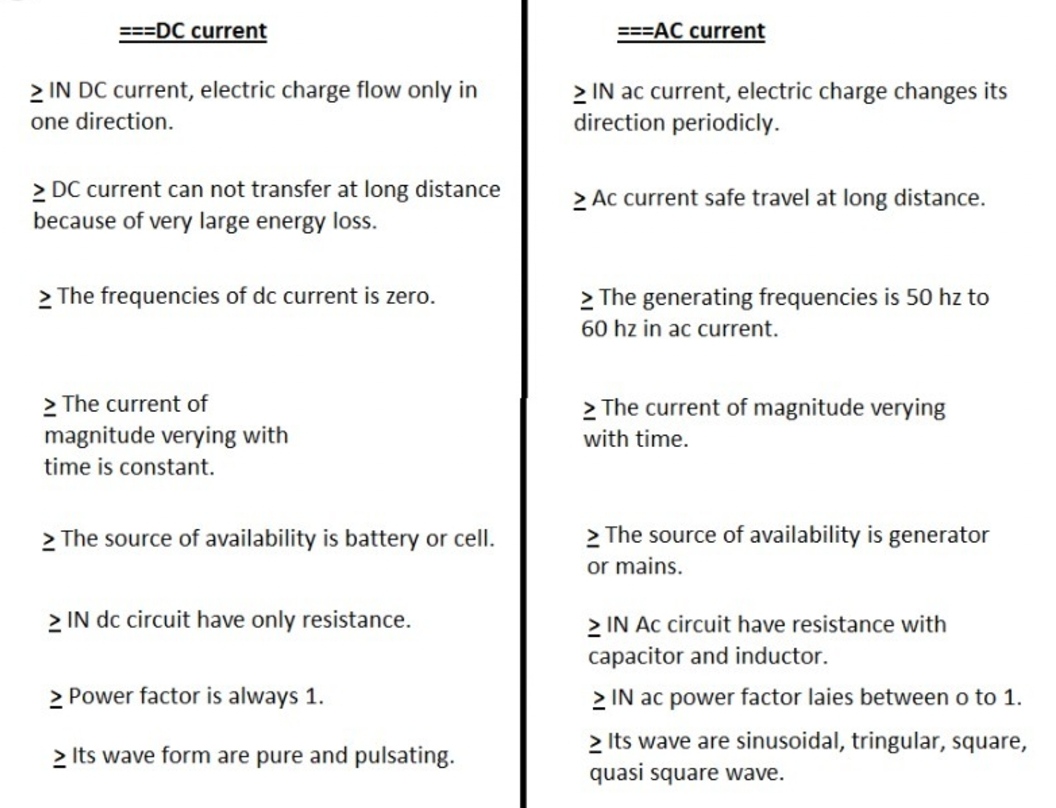AC vs DC The Shocking Truth About Electricity
Ever wonder what that little squiggle (~) next to the voltage rating on your power adapter means? It signifies alternating current (AC), a fundamental concept in electrical engineering. Its counterpart, direct current (DC), is indicated by a straight line (⎓) or sometimes the letters "DC." Understanding the difference between these two forms of electricity isn't just for electrical engineers; it's about empowering yourself to make smart choices about everything from appliances to home wiring.
Distinguishing AC from DC is like understanding the difference between a seesaw and a slide. With AC, the electrons in the wire constantly switch directions, flowing back and forth like kids on a seesaw. DC, on the other hand, is a one-way street. Electrons flow steadily in a single direction, like sliding down a playground slide. This fundamental distinction has huge implications for how we generate, transmit, and use electricity.
The story of AC versus DC is a fascinating tale of ingenuity and rivalry. In the late 19th century, titans of industry like Thomas Edison (championing DC) and George Westinghouse (backing AC) clashed over which system would power the world. Edison's DC system was initially popular, but it suffered from a major drawback: it was difficult to transmit efficiently over long distances. AC, however, could be easily stepped up to high voltages for efficient long-distance transmission and then stepped down for safe use in homes and businesses. This key advantage ultimately led to AC's dominance in power grids worldwide.
Comparing AC and DC is crucial because it dictates the types of devices we use and how our electrical infrastructure is designed. From the power plants that generate electricity to the chargers for our phones, the choice between AC and DC is paramount. Understanding the core differences empowers us to troubleshoot electrical issues, choose the right appliances, and appreciate the ingenuity behind the electrical systems we rely on every day.
Differentiating between AC and DC goes beyond simply knowing their symbols. It involves understanding their inherent properties. AC's fluctuating nature allows for efficient voltage transformation using transformers, a key element in the power grid. DC, with its constant voltage, is ideal for electronic devices and batteries. This difference is why your laptop, which runs on DC, requires an AC adapter to plug into the wall socket.
One significant benefit of understanding the AC/DC difference is choosing the right power source for your devices. Plugging a DC-only device directly into an AC outlet can damage it. Conversely, some AC devices might not function correctly with a DC source. Being able to discern these differences can save you money and frustration.
Another advantage of understanding AC and DC is the ability to troubleshoot simple electrical problems. If a lamp doesn't work, you can check if the issue is with the AC power supply or the DC circuitry within the lamp itself. This knowledge can help you determine if it's a simple fix or requires professional assistance.
A third benefit lies in appreciating the broader electrical landscape. Understanding the AC/DC difference provides insight into why power lines crisscross the countryside at high voltages (AC) and why batteries are essential for portable electronics (DC). This awareness can spark curiosity about renewable energy sources, smart grids, and other emerging technologies.
Advantages and Disadvantages of AC and DC
| Feature | AC | DC |
|---|---|---|
| Transmission | Efficient over long distances | Inefficient over long distances |
| Voltage Transformation | Easily changed with transformers | Difficult and expensive to change |
| Safety | Higher voltages pose greater risk | Lower voltages generally safer |
| Applications | Power grids, home appliances | Electronics, batteries, solar panels |
Frequently Asked Questions about AC/DC:
1. What does AC stand for? Alternating Current
2. What does DC stand for? Direct Current
3. Why is AC used for power transmission? Because it can be easily and efficiently transmitted over long distances.
4. Why is DC used in batteries? Batteries chemically produce a direct current flow.
5. Can I plug a DC device into an AC outlet? Not directly, you need an AC adapter.
6. What is the frequency of AC power in the US? 60 Hertz (cycles per second).
7. What is an example of a DC appliance? A flashlight.
8. What is an inverter? An inverter converts DC power to AC power.
In conclusion, understanding the difference between AC and DC is not just about electrical theory; it’s a practical skill that can help you make informed decisions about your electronics, troubleshoot problems, and appreciate the complex electrical world around us. From the power grid that lights our homes to the batteries that power our phones, AC and DC play vital roles in our modern lives. By grasping the fundamental differences between these two forms of electricity, you empower yourself to navigate the electrical landscape with confidence and make smarter choices about the technology you use every day. This knowledge not only enhances your understanding but also helps you avoid costly mistakes and appreciate the ingenuity behind the electrical systems that power our world. So next time you plug in a device, take a moment to consider the flow of electrons and the fascinating story of AC versus DC – the unseen forces that keep our world running.
Finding the perfect happy palm sunday gif a guide to digital celebrations
Unlocking success your guide to karangan pt3 bahasa melayu
Behr harmonious white review is it really that harmonious


-vs-direct-current-(dc).png)



